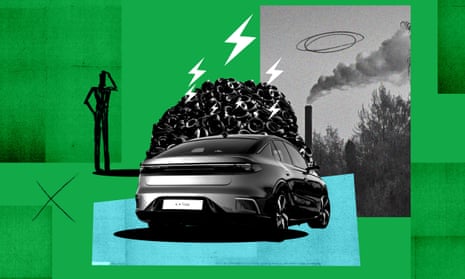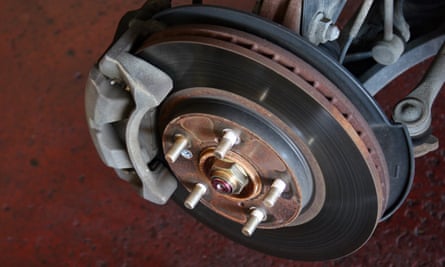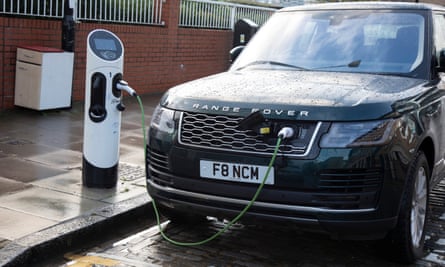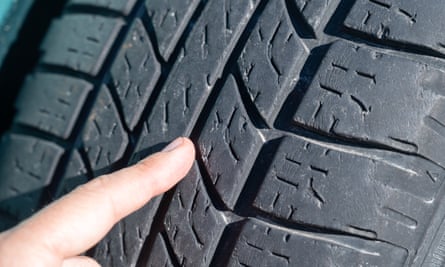
Do electric cars have an air pollution problem?
In part seven of our series exploring myths surrounding EVs, we look at claims friction on brakes and tyres will affect air quality
Toxic smog has been a part of big city life since the Industrial Revolution: a pea-soup blanket of harmful particulates that can be so thick that seeing and breathing is difficult. Yet in many cities in the rich world that dirty pall has been banished as car engines have got cleaner and factories have moved away. (Poorer cities are not yet so lucky.)
Some people believe that the shift to electric cars could reverse some of that progress: that heavier cars and the particulates they produce by friction mean we could sacrifice cleaner air on the altar of zero carbon emissions.
In the EV mythbusters series the Guardian has examined claims about electric vehicles (EVs) looking at issues ranging from carbon emissions and battery fires to the idea of hydrogen overtaking them. The latest in our series asks: do electric cars have an air pollution problem?
The claim
Electric cars reduce engine pollution to zero, but their brakes and tyres still rely on friction to work. That friction breaks down materials, which can then end up in the environment. Some people claim that the shift to EVs, which tend to be heavier and therefore cause more wear, could cause overall air pollution to increase.
In 2022 the UK’s then environment minister, George Eustice, told parliament of “scepticism” over air quality improvements. “Some say that just wear and tear on the roads and the fact that these vehicles are heavier means that the gains may be less than some people hope, but it is slightly unknown at the moment,” he said.
The Daily Mail reported that tyre pollution was the “dirty secret of electric cars”, while the Sun reported that “EV drivers have been warned over ways that their super heavy electric cars actually end up producing MORE pollution than petrol and diesel motors”.
The science
EVs do not burn fossil fuels directly – and would not release any emissions at all if produced using only zero-carbon power. As well as carbon dioxide, that means no release of carbon monoxide, nitrous oxides and a cocktail of carbon, metals and unburnt hydrocarbons in built-up areas. (Fossil fuel power stations are still problematic for charging electric cars, but they tend to be away from population centres in richer nations.)
However, all cars produce particulate matter (PM) from friction on brakes, tyres and road surfaces – leaving a dusty trail of pollution in the air and on the ground. That pollution contains harmful chemicals: one additive, washed from roads to rivers, was found to be the cause of mass death of coho salmon on the US west coast.

On the brake front, electric cars generally produce less particulate matter because they use regenerative brakes to stop, according to Euan McTurk, a battery chemist who has examined the particulate issue for the RAC. EV brakes wear down much slower, he said.
But electric cars do have a case to answer on roads and tyres because increased weight means greater wear. Transport & Environment, a campaign group, has calculated that EVs are about 400kg heavier on average because of bulky batteries.
Many of the claims about EVs causing air pollution reference figures from Emissions Analytics, a private company. Founder Nick Molden said that its measurements show that particulate emissions can be 1,850 times more than those from modern car exhausts, which have become cleaner because of regulations. But that headline finding needs some context: the tests have not been peer-reviewed by scientists, and the industry disputes the findings.
Crucially, all cars produce those pollutants – not just electric versions. Measuring tiny particulates is very difficult, and there are relatively few comparative studies so far. That means that there is still uncertainty over whether the extra weight of EV batteries will result in worse particulate pollution.

The German tyre maker Continental said vehicle and tyre design is less important in determining wear than driving style and the curves of the road (a point also made by Molden). A Continental spokesperson said: “In principle, EVs do not produce more particulates than an otherwise similar internal combustion engine vehicle just because of the battery-induced increased weight.”
There are a lot of moving (and rubbing) parts in any calculation, but some efforts have been made to tot it all up. A study by the Organisation for Economic Cooperation and Development in 2020 estimated “the uptake of electric vehicles will lead to very marginal decreases in total PM emissions from road traffic in future years”. The study found heavier electric cars cause marginally more road and tyre wear for the larger PM 10 particles and the smaller PM 2.5. Yet once engine pollution is added in, petrol and diesel cars were marginally worse.
after newsletter promotion
Any caveats?
There is broad agreement that tyre pollution is still harmful. Many scientists believe that smaller PM 2.5 matter is more damaging, because it can enter the bloodstream and pass into the brain or the placenta.
Tyremakers are looking at adjustments to their chemistries. The Tyre Collective, a UK startup, has an elegant potential solution: an electrostatic device that will catch tyre particulates, potentially for recycling into new tyres.
“Tyre wear has always been a problem,” said Hanson Cheng, the Tyre Collective’s founder. “It has just been overshadowed. You can’t really claim the title of zero-emission vehicle if there are all these non-exhaust emissions.”

Whether petrol or electric, tyre pollution will get worse if the SUV juggernaut continues. Cars are getting ever taller, wider and heavier (which will worsen carbon emissions and energy efficiency).
Anna Krajinska, Transport & Environment’s manager for vehicle emissions and air quality, said that there was no conclusive evidence on whether electric cars will increase particulate emissions – but added that we should try to limit the shift to SUVs.
The verdict
There is no doubt that the car industry still has pollution questions to answer. As the end of the internal combustion engine advances, expect more focus on particulate pollution from tyre wear, as it is one of the few sources of pollution while the car is in use. That could offer big health benefits for humans, flora and fauna.
It is certainly the case that ever heavier cars almost certainly produce more tyre particulates. Electric cars are – for now – heavier still than equivalents. But even so, tyre pollution appears roughly comparable between petrol, diesel and electric cars. The other benefits of switching to electric cars – most notably lower carbon pollution – are huge.
Fighting air pollution is an important cause, but it does not appear to offer a reason to delay the transition to electric cars.